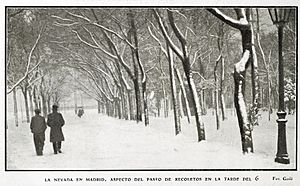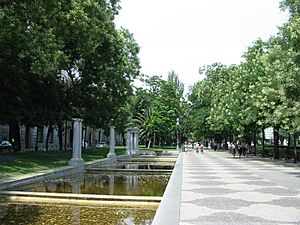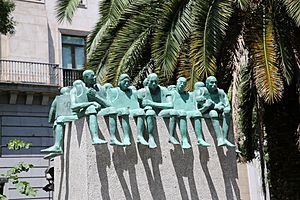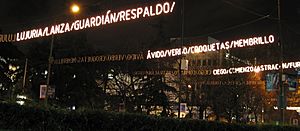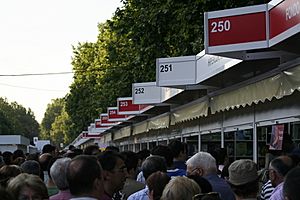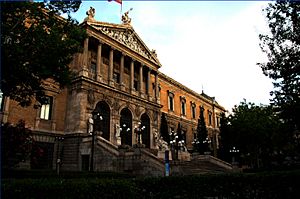Paseo de Recoletos facts for kids
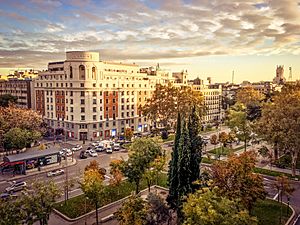 |
|
| Type | Boulevard |
|---|---|
| Location | Madrid, Spain |
| Coordinates | 40°25′19″N 3°41′30″W / 40.4220°N 3.6918°W |
| South end | Plaza de Cibeles |
| North end | Plaza de Colón |
Paseo de Recoletos is a wide and beautiful street in central Madrid, Spain. It stretches from Plaza de Cibeles to Plaza de Colón. This famous boulevard is known for its lovely gardens, statues, and historic buildings. It's a great place for a walk and to see some of Madrid's history!
The street has many lanes for cars and buses. In the middle, there is a special walking area. This area is lined with trees, flowers, and interesting statues.
Contents
History of Paseo de Recoletos
The Paseo de Recoletos was created in the late 1700s. King Charles III asked architect José de Hermosilla to design this area. It was built along an old riverbed. The street got its name "Recoletos" from an old convent built nearby in 1592. This convent belonged to a group of friars called the Augustinian Recollects.
The Old Gate and War
Originally, the boulevard ended at an old gate called Puerta de Recoletos. This gate was built in 1756 and taken down in 1863. During the Peninsular War (also known as the Napoleonic Wars in Spain), this gate was made stronger. It helped defend Madrid from Napoleon's troops in 1808.
Napoleon himself led attacks against Madrid. The Spanish soldiers at Recoletos Gate fought bravely. Even though the French eventually broke through other parts of the city, the defenders at Recoletos held their ground for a while. Madrid finally surrendered the next day.
Civil War Changes
During the Spanish Civil War (1936-1939), the statues and fountains along the Paseo de Recoletos were covered. They were hidden to protect them from damage. Because of this, people sometimes called the area "of the twilight of the gods."
Exploring the Pedestrian Walk
The middle part of the Paseo de Recoletos is a special area just for people walking. It's filled with beautiful gardens, tall trees, interesting statues, and pretty fountains. You can also find many benches and other street furniture here.
Ponds and Cafes
The first and longest part of the pedestrian walk has eight ponds. These ponds are lined with white columns and light up at night. Water flows from one pond to the next, creating small waterfalls. Some ponds even have little jet fountains.
Nearby, you can find the Terraza Recoletos, an outdoor café. There's also an interesting Equatorial Sundial that tells time using the sun.
Further along, you'll find the Café Gijón. This is a very old and famous literary café. It opened in 1888 and has an outdoor seating area on the boulevard. Many writers and artists have visited this café over the years.
Statues and Art
On the last part of the walk, there's another charming café called Café El Espejo. It has a beautiful glass building that looks like something from the Art Nouveau style. This section also has a monument dedicated to the Spanish writer Juan Valera. It features a statue of him and his famous book, Pepita Jiménez. You can also see a statue of another writer, Ramón del Valle-Inclán, and a drinking fountain.
Near the end of the walk, there's an entrance to an underground tunnel. This tunnel leads to another green area of the boulevard. This tunnel even appeared in a movie called Taxi (1996)!
Eastern Green Area
The eastern side of the Paseo also has a green area. The northern part of this area is narrow. It has a special stone that remembers the 30th anniversary of the Children's Rights declaration. There's also a small metal sculpture of two children reading. This sculpture is dedicated "to the Book and its creators" and is located in front of the National Library.
The other parts of this eastern strip are wider. They have paths for walking, surrounded by trees, bushes, and colorful flowerbeds.
Events and Exhibitions on the Paseo
The pedestrian walk on Paseo de Recoletos often hosts different events throughout the year.
Book and Craft Fairs
Several times a year, you can find stands set up along the walk for various fairs:
- The Secondhand Book Fair is held in April or May.
- The Craftsmanship Fair takes place during the Christmas season.
- An Old Book Fair is held in the autumn.
Art and Culture
The Paseo de Recoletos is also used as an outdoor art gallery. Large sculptures and art pieces are often displayed here for a few months. For example, in 2006, ten sculptures by artist Robert Indiana were shown. In 1994, 21 sculptures by Fernando Botero were displayed along the walk.
Other cultural events happen here too. On March 27th, people celebrate World Theatre Day around the Valle-Inclán statue. They give out a special prize and read a letter about the importance of theater.
During Christmas 2004, the Paseo was decorated with rows of illuminated words. These words, designed by artist Eva Lootz, lit up slowly in waves, creating a magical atmosphere.
Buildings on the East Side
Many important and historic buildings line the Paseo de Recoletos.
National Library
One of the most famous buildings is the National Library. It's located at numbers 20/22 on the boulevard. This building was originally built around 1568. Since 1711, it has housed the National Library and the National Archeological Museum.
Salamanca Palace
At number 10, you'll find the beautiful Marqués de Salamanca Palace. It was built between 1846 and 1855 in a Renaissance style. This grand palace has been home to banks and now houses the BBVA Foundation.
Linares Palace
Right next to Plaza Cibeles, at Recoletos number 2, stands the Marqués de Linares Palace. This palace was built in 1873. For a long time, this land was used as a large warehouse for grain.
In 1976, the palace was declared a "Historical-Artistic Monument." This helped save it from being destroyed. Today, after much restoration, it is home to the Casa de América. This center promotes cultural exchange between Spain and the Americas.
Buildings on the West Side
The west side of the Paseo also features several interesting buildings.
Modern Offices and Historic Convents
At number 3, there's a modern office building. Numbers 7 and 9 are part of a building owned by a famous business person, Alicia Koplowitz. The British Consul General's office is located here.
Next to it is the Convent of San Pascual. It was founded in 1683. Over the years, it has been used for different purposes. In 1836, it became a wood warehouse. Later, the Franciscan nuns returned. The current building was built in 1866. Today, the nuns still live there, and a special old Spanish church service is held every Tuesday.
Palaces and Headquarters
Number 13 is home to the Palace of Alcañices. It was built in 1865 and is a great example of a wealthy family's home from the 1800s. The building next to it, at number 15, is the Palace of López Dóriga, built in the same style. The block ends with the Houses of the Asociación Mutua Benéfica, which now belong to the Ministry of the Navy.
A modern glass building stands out at number 19. This is the headquarters for Banco Pastor, a bank.
At number 23, you'll find the Palace of Duchess of Mediana de las Torres. It was built on the site of an old circus that burned down. The two towers on the sides of the building were added in 1910. The Palace of Elduayen (number 25) is next to it and is now owned by the Mapfre Insurance Company.
See also
 In Spanish: Paseo de Recoletos para niños
In Spanish: Paseo de Recoletos para niños


